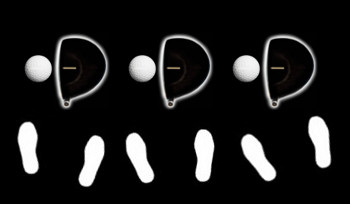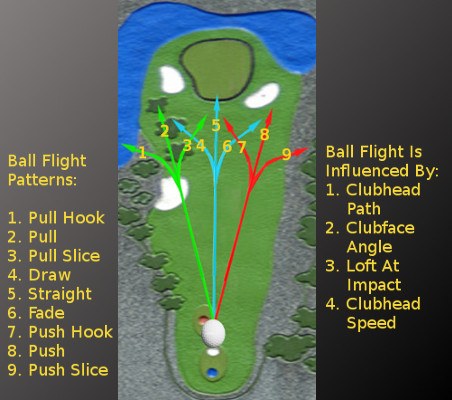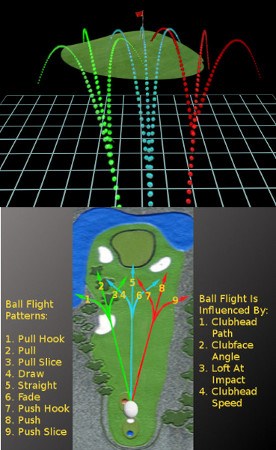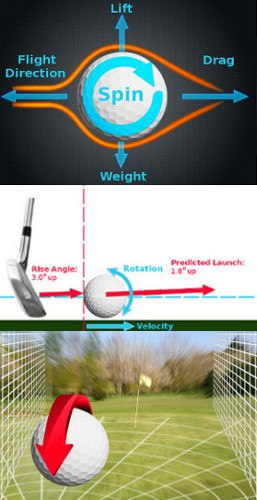
When teeing off on a straightaway hole, the natural inclination is to line up in the middle of the tee to play a straight shot. But if you aim directly for the center of the fairway, you decrease your chances of hitting it.
Fact: Nearly every golf shot, especially those hit with a driver, has some amount of curve. Therefore, if you aim down the middle and hit a fade (rightward curve for a right-handed golfer), the ball will finish right of the target – potentially in trouble such as a hazard or rough.
Your best bet is to account for your usual shot shape from the start. If you tend to fade the ball, line up down the left-hand side of the fairway. Do the opposite if you expect a right-to-left ball flight (draw).
Another good tactic is to tee the ball up on the side of the tee to which your ball curves. For example, if you plan to hit a fade, tee off from the right side while aiming left. This effectively widens the space in which you can safely turn the ball and still find the fairway.

Curve Your Shots to Hit Straight Fairways?
When you stand up on the tee of a par four or par five and see a straight fairway, you probably breathe a sigh of relief. After all, a straight fairway is easier to hit than one which features a dogleg, right? Well, not necessarily. While there is something to be said for seeing the fairway stretching out straight in front of you, a straight hole also presents a number of challenges. Specifically, you will have to figure out how you are going to shape your shot in order to hit the fairway, as the hole will not be making that decision for you.
For many players, a straight hole means they are going to attempt to hit a straight shot. There is only one problem with that plan – it is nearly impossible to hit a straight shot in this game. Sure, you might be able to hit the ball straight when playing a short pitch, but not when hitting a driver as hard as you can. The ball is bound to curve in one direction or the other, so planning for a straight ball flight is basically planning for failure. You should always plan on the ball having some amount of curve, even when you are facing a fairway which takes a straight path from tee to green.
The ability to plan and predict your curves accurately is one of the skills which can take you to a new level in this game. Relatively few amateur golfers ever get to this point, as most simply aim for the target and hope for the best. While you will never be able to curve the ball as you plan on every single shot – no one has that level of consistency in golf – you can get better and better and this part of the game over time. Not only will predicting the size and direction of your curves help you to get the ball close to the target, it will help you to keep the ball out of trouble as well. For instance, if there is a hazard down the right side of the hole, you can turn the ball to the left in order to stay safe.
In this article, we are going to talk mainly about planning your tee shots when facing a straight fairway. If you are like most golfers, you probably haven't thought about this point very much in the past, because it seems like a no-brainer. Most likely, you have just aimed down the middle on these kinds of holes to give yourself margin for error on both sides of the target line. As you will soon see, however, this is not the optimal strategy for a straight hole. By changing your way of thinking, you can hit more of these fairways – and lower your scores in the process.
All of the content below is based on a right-handed golfer. If you happen to play left-handed, please take a moment to reverse the directions as necessary.

The Challenge of a Straight Fairway
Sometimes, in golf, it is the subtle challenges that are the most significant. Hitting over a big water hazard is anything but subtle, so it grabs your attention right from the start. You know that you need to get the ball safely over the water above all else, so your focus will be strong as you prepare to hit the shot. The story is different when playing a tee shot to a straight fairway. You aren't going to see any obvious signs of trouble in front of you, so your guard may be let down a bit prior to making the swing. Of course, this is exactly when things will go wrong. It is possible to get into trouble on any golf shot, no matter what lies in front of you. Even when playing to a straight, wide fairway, you need to focus on the task and hand and execute to the best of your ability.
Now that you understand the focus required to play this – or any other – shot, we are going to look at some specific problems posed by a straight fairway. The points below should highlight why this kind of shot is much more difficult than it appears at first.
- No angle to work with. When playing a tee shot into a fairway which features a dogleg, you can actually use that dogleg to your advantage. For example, if the hole is curving from right to left, you can make the target bigger by playing a left to right shot. Fading the ball into a fairway which is shaped to match a draw is often a good idea because you will be approaching the fairway from the side – meaning it is effectively wider. This is not a strategy you can use on a tree-lined fairway, but it works great as long as you have airspace to work with. On a straight hole, there is no way to use this angle advantage. In the end, a straight fairway is going to be harder to hit in many cases, simply because you can't work your ball flight in from the side like you can on a dogleg hole.
- Hard to pick a target. Another advantage of playing a dogleg hole is the fact that you can usually pick out a target in the distance to serve as the aiming point for your drive. This may be more difficult on a straight hole. Even if you do find something off in the distance to aim at, it will frequently be harder to identify than on a hole with a dogleg and more features to pick out from the tee. It is important to have a specific target for all of your tee shots, and that task gets a little tougher when the hole is perfectly straight.
- Tempting to swing too hard. With all of that open fairway stretching out in front of you, it might be tempting to swing as hard as you possibly can. This is obviously a mistake, but it is still an easy trap to fall into. On a dogleg hole, you probably won't have this urge, as you know that hitting the ball too far through the dogleg is going to lead to trouble. If you are going to succeed on straight holes, you need to resist the temptation to swing extra hard and instead focus on making a smooth move through the ball.
Straight golf holes look simple enough, but there is almost always trouble waiting to be found if you get off track. You need to focus on the key fundamentals of your swing when playing these kinds of tee shots, and you need to have a specific plan in mind before standing over the ball. There are usually at least a few straight holes included within the design of any golf course, so having the ability to get through these holes cleanly is important in terms of your overall score.

How to Use Your Curve on a Straight Hole
For the purposes of this discussion, we are going to assume that you already are able to predict your curve off the tee with relative consistency. If you still struggle to plan for a draw or fade reliably, you will need to go back and work on that point before you can really strategize on straight holes. The ability to control your ball flight in golf is one of the most important skills you can develop.
Once you know which way the ball is going to turn most of the time off the tee, you can start to plan your shots accordingly on the straight holes. Let's say for a moment that you usually hit a slight draw with your driver. That is good news, of course, as a draw tends to travel further than a fade for most players. So are you going to aim that draw right down the middle of the fairway on the straight holes? No – that would be a mistake. Instead, you should be aiming the ball down the right edge in order to let it work back toward the middle. By aiming down the right side, you will be giving yourself the entire fairway to work with, meaning the target will be effectively wider than if you had aimed right down the center.
Think about it this way – if you aim down the middle and hit a draw, you are only playing with one half of the fairway. The right side of the fairway is essentially out of play, assuming you do hit a draw. This kind of shot will either end up in the left side of the fairway, or it will miss the fairway to the left. By adjusting your aim down the right side instead, you now give yourself much more territory to work with. If the ball only draws slightly, you may find your fall in the right side of the fairway, while a bigger draw could still catch the left side. There are more possibilities for good outcomes with this plan.
In addition to effectively giving you more fairway to aim at, this plan is also a great way to simplify your game. When you step up to a straight hole, you will automatically know what you are going to do – aim down the opposite side of your curve to play to the widest possible target. This makes it easy to prepare for your shot, and it takes some of the stress out of your round. Having this kind of 'built in' game plan will go a long way toward adding decisiveness to your decision making process.
One thing to keep in mind is that you want to avoid aiming in a direction where a straight shot will hurt you. In other words, you don't want to aim directly into the rough just in case the ball does fly straight. By aiming right down the edge of the fairway, you should still be in pretty good shape if you hit a straight ball – and you should be in a perfect spot if the ball draws like you expect. No matter what kind of shot you are hitting, this is a good tip to keep in mind all around the course. Plan for your curve but pick a line that won't hurt you if the ball comes off straight. It isn't always possible to play this way, but doing so when you can will help lower your scores.

Considering the Slopes
While a fairway may be straight from tee to green, that does not mean that it is necessarily flat. In fact, many straight fairways will have slopes, humps, and bumps along the way meant to complicate things for the golfer. If that is the case on some of the holes at your home course, you are going to need a clear plan of attack to make sure those slopes don't throw you off track. The tips below will help you deal with the slopes that may be built in to a straight hole.
- Curve the ball into the slope. If you have the ability to curve your tee shot in either direction on command, this is the time to pull out that skill. When the fairway is sloped from side to side, you are going to want to curve the ball into that slope in order to hold the ball in the short grass. So, for instance, if the ground is sloped from right to left, you are going to hit a left to right shot into the slope. If you were to take the opposite approach and curve the ball in the same direction as the slope, it is very likely that the ball would run out of the short grass and into the rough.
- Try to play away from severe slopes. This is a tip you will use with your second shot in mind. If you are playing a tee shot into a fairway with a section that is severely sloped, do your best to stay away from that part of the short grass. This is an instance where you would be willing to go against your normal strategy of aiming down one side and turning the ball into the middle. For instance, if it is the right half of the fairway that is badly sloped, do what you can to find the left side – even if you have to break from your usual game plan. In fact, it would be okay to miss in the left rough in this case, as long as the rough is not particularly long. Playing shots from severe slopes is never easy, so you want to avoid that outcome whenever possible.
- Use a downslope to your advantage. What is the quickest way to add distance to your drives? It isn't to buy a new driver, or even to work on your swing mechanics. Instead, the fastest way to add yards to your drives is to land the ball on a downslope. If the fairway in front of you has a section which is tilted toward the green, do your best to hit that part with your tee ball. The bounce and roll that you receive will add significant distance to your shot, leaving you a shorter approach in the end. Of course, you don't want to take on any unnecessary risk in order to find the downslope, so be smart and only aim for the slope when it is safe to do so.
Golf would be a rather boring game if every course was perfectly flat. It is the slopes of the course which make it interesting and memorable, but slopes also add a significant challenge. Use the tips above as you plan your tee shots in order to make the most out of the slopes you find in the fairway. By making smart decisions, you can actually cause these design features to work in your favor.

Doing Some Math
Most of us don't like to do math at our desks, let alone while we are out on the golf course. However, there is quite a bit of math involved in golf, whether you are calculating your yardage to the flag or adding up your score for the front nine. Another area where you should be doing some math is while you are standing on the tee of a hole which features a straight fairway. Since the@ fairway travels straight from tee to green, you are free to hit the ball as short or long as you would like with your first shot. This is not a freedom that you enjoy on a dogleg hole, where your ideal driving distance is often determined for you by the shape of the course.
Unfortunately, many golfers just stand up on the tee and automatically pull their driver from the bag when faced with this situation. That is a mistake, of course, as the shot might not call for a driver – even if the fairway is straight and plenty wide. At this point, you are going to need to do some math in order to determine the ideal club to put in your hands on the tee. It might turn out to be a driver that is the right club after all, but don't jump to that conclusion before some numbers have been crunched.
So what kind of math are you going to be doing? Don't worry – this will be very basic math, but it will go a long way toward giving you a chance to complete the hole with a par, or even a birdie. As you stand on tee, consider the total distance of the hole and think about the number you would like to have remaining for your approach shot. For instance, if the hole is 350 yards total, and you are comfortable hitting approach shots from 125 yards, you will want to hit a tee shot roughly 225 yards. What club in your bag will send the ball 225 yards? Is it the driver, or maybe the three wood? Whatever the case, use that club to set yourself up perfectly for a comfortable approach into the green.
One of the common mistakes made by amateur golfers playing the middle or 'white' tee is using too much club off the tee on relatively short par fours. If a par four is 320 yards with a straight fairway, you might take your driver out and knock it up within 75 yards of the green. There is only one problem with this plan – 75-yard approach shots can be tough to play. Depending on the location of the hole and the design of the green, you might have your hands full with such a shot. Laying back to 100 yards may have been the better option, meaning a three wood from the tee would have been the right play.
Never make the mistake of assuming that a longer drive is always better. Sure, setting up short approach shots certainly can be a good thing, but only in the right situation. You need to think about your own personal skills, as well as the conditions of the course when deciding on an ideal approach distance. Once you settle on a number you are comfortable with for the hole in front of you, do some quick math and pick the right club for your tee shot.
The next time you stand on the tee of a straight par four or five, consider using an intentional curve to find the middle of the fairway. This might not be the most obvious strategy at first, but it is going to be the best bet over time. Turning the ball into the short grass will make the target wider, and it will help you to avoid hazards and other obstacles as well. You don't always need to change your swing to improve in this game – sometimes it's as easy as using a new, smarter course management strategy. Good luck!






